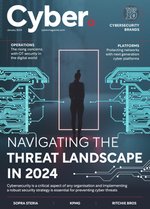Protecting networks through cybersecurity platforms

As cyber threats become increasingly sophisticated, it is more crucial than ever for businesses to prioritise cybersecurity measures. By investing in robust cyber solutions, organisations can safeguard valuable data, protect systems from potential breaches, and maintain smooth operational continuity.
In today’s business landscape, organisations are increasingly reliant on technology and the Internet to run day-to-day operations. This dependence, however, comes with a heightened risk of cyberattacks, a growing threat that organisations must take seriously. Cybersecurity is no longer just an IT issue; it has become a critical business goal to protect companies from the potentially devastating consequences of cyberattacks.
The main challenges that enterprises face today
In order to safeguard from sophisticated cyberattacks, enterprises need to ensure that every aspect of cybersecurity is accounted for. Quentyn Taylor, Senior Director of Product, Information Security and Global Incident Response at Canon for EMEA, says: “An emerging challenge for enterprises has been to adapt cybersecurity practices to hybrid working environments and one aspect that’s often overlooked is the security of print and scan workflows. Data suggests that despite 70% of organisations being reliant on printing, over a quarter (27%) of IT security incidents are related to paper documents.
“A recent IDC report found that 43% of respondents cite that ensuring at-home printing devices are compliant with corporate governance and security policies continues to be a significant challenge.”
During the coronavirus pandemic, the transition to hybrid work arrangements introduced a new layer of complexity to cybersecurity, expanding the attack surface and making it more challenging for enterprises to defend against threats. Nowadays, this flexible and convenient work model is irreversible, meaning enhanced defence measures and continuous monitoring outside of company premises are crucial.
Tristan Morgan, Managing Director of Cyber Security at BT, explains: “As a company’s infrastructure evolves, it becomes a mixture of systems integrating new, established and legacy technology from a wealth of different suppliers. This can make it increasingly difficult to gain full control and transparency over an IT environment.
“As enterprises try and keep up with the pace of digitisation around them, their own digital transformation will mean network security becomes a problem for their overall business and not just a technology problem. This will require a step change in cybersecurity operations, as data, applications and services flow ceaselessly around the globe.”
Understanding the benefits that cybersecurity platforms bring to enterprises
Cybersecurity platforms serve as a critical defence mechanism for enterprises, helping them to identify, assess, and neutralise cyber threats. By providing an integrated suite of security solutions, these platforms enable organisations to detect the early signs of attacks and take timely corrective measures to prevent damage and ensure business continuity.
David Emm, Senior Security Expert at Kaspersky, comments: “For ‘traditional’ cyberattacks carried out by opportunistic cybercriminals, established anti-virus defences remain effective. However, to combat more advanced attacks, a comprehensive protection strategy is essential. This involves understanding what normal network activity looks like, flagging any anomalous behaviour and taking remedial steps. This level of comprehensive threat intelligence requires the integration of all tools deployed on endpoints throughout the network.”
Implementing the latest security controls is crucial to keeping pace with the ever-evolving threat landscape. As cybercriminals continue to develop new attack methods and techniques, organisations must ensure that their defences are up to date to remain effective.
“Endpoint Detection and Response (EDR) is a key solution for enterprises of all shapes and sizes,” Morgan explains. “As this platform can combine antivirus, threat hunting and threat intelligence, anything malicious that takes place on the end-user device can be identified and stopped. Alongside this, threat detection through SIEM (Security Information and Event Management) systems can detect compromises within the wider network estate, so organisations can stop threats before they even reach the end device.”
Implementing cybersecurity platforms in enterprise networks
Whether an organisation is a small startup or a large multinational corporation, the successful implementation of cybersecurity platforms depends on having a well-defined process and a robust plan.
“While the specifics of the plan may differ based on the organisation's size, some fundamental questions should be addressed,” says Emm. “These include an audit of corporate systems, a risk assessment (including the company’s partners and suppliers) and, from this, an understanding of the policies, procedures and tools appropriate to defend the organisation.
“A key practice is to adopt a proactive mindset and consider security from the perspective of an attacker, asking questions like ‘How would I go about obtaining this information if I were an attacker?’ From there, businesses can better shape their cybersecurity plan and determine whether they have the necessary in-house expertise or if external assistance is required.”
By providing valuable insights, information, and real-time threat intelligence, cybersecurity platforms serve as critical partners, helping organisations to navigate the complexities of cybersecurity.
Taylor explains: “When implementing a cybersecurity strategy, enterprises should focus on building a well-rounded framework from the ground up, one that encompasses proactive threat intelligence, robust defences, continuous monitoring, and incident response plans.”
Cybercriminals will never stop trying to invent new ways of attacking businesses for their own personal gain. “Enterprises should consider leveraging analytics and user behaviour analysis to detect any unusual patterns,” says Morgan. “Unexpected behaviours when it comes to business processes, such as unexpected transaction volumes or first-time activity, can mean you are far more likely to identify and prevent financial cybercrimes from taking place.”
Securing the future of network security
When looking to the future, there are several trends which could bring substantial benefits to enterprises. Taylor considers the emergence of AI as one trend that will continue to define the evolving cybersecurity landscape. “One of the key benefits of AI is its microtargeting and auto-generation capabilities, meaning cyber defenders can detect and block attacks with greater precision, and reduce the time between identification and mitigation,” he explains. “AI can also support organisations in designing Custom Learning Journeys that educate and train staff in cybersecurity as part of a highly tailored educational program, specific to their enterprise and its needs.”
By minimising vulnerabilities and reducing their attractiveness as targets, enterprises can reduce the likelihood of cyberattacks, Emm remarks how enterprises are shifting their focus from post-incident response to proactively enhancing their resilience and mitigating potential financial losses in the event of a breach.
Morgan concludes: “We’ve seen automation emerge as a growing trend, being embraced by enterprises to improve network security, with security automation for email phishing a good example of saving time. As computing environments become more software-based, enterprises can utilise advanced methods of automation to improve the level of integration between their security tools and the quality of threat detection.”
******
Make sure you check out the latest edition of Cyber Magazine and also sign up to our global conference series - Tech & AI LIVE 2024
******
Cyber Magazine is a BizClik brand







